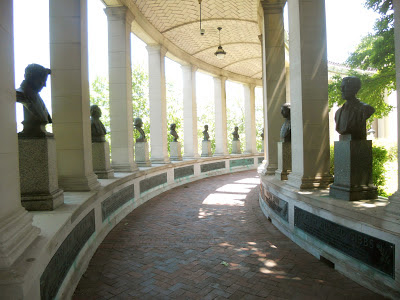Washington Heights
Manhattan
There are enough bike
paths in NYC that it is almost possible
to ride around the entire perimeter of Manhattan Island. And, if proposed bike
paths get completed, aforementioned feat should soon be accomplishable. Don’t
get too excited, though, as several projects that were slated to be completed
Spring 2012 are still behind locked fences.
Thanks to incomplete bike routes, Highbridge Park isn’t as easy to get to as it could be, but once you get there you will find one of the three mountain bike paths in NYC, and the only one located in Manhattan (the other two are in Queens and Staten Island). Be forewarned, though, as this path far enough off the beaten that you will encounter at least one or two makeshift shanty homes. Think of it as local color.
Highbridge Park is named
after High Bridge, the oldest standing bridge in NYC, and one of the city’s few
pedestrian-only bridges. High Bridge opened in 1848 as part of the Croton
Aqueduct. The aqueduct was developed to bring fresh water to the rapidly growing city and prevent future cholera epidemics like the city had seen through much of the 1820s and 30s.
Highbridge Park developed piecemeal between 1867 and 1960, with majority of it
acquired between 1895 and 1901. The park lies in several chunks on both the
Manhattan and the Bronx sides of the bridge.
Cars were never allowed
on High Bridge, only pedestrian and bike traffic. When the construction of
major expressways caused the popularity of the waterfront to fade, in 1923 the city
proposed demolishing High Bridge, something which was vehemently opposed
by the public. Repairs and alterations were later made on the bridge to make it possible for large ships to pass under it, but the Croton Aqueduct
was removed from service in 1958 and not long after the bridge was closed to
traffic of any kind. The story is the bridge was closed due to hooligans
throwing things off it onto passing Circle Line boats in the Harlem River.
One of the stunning
architectural features of Highbridge Park—aside from the bridge itself, which
was originally made of fifteen imposing Roman stone arches—is the High Bridge Water Tower.
The tower was designed by famed engineer John Jervis in 1872 and keeps with the
Romanesque Revival architectural theme of the bridge. The tower was damaged in
an arson fire in 1984 but was later repaired in 1990. Visitors used to be able
to go up the winding interior staircase on ranger led tours to see magnificent
views of the surrounding city, and the tower was a popular destination during
Open House New York. Unfortunately, tours were halted in 2010 due to concerns
over the stability of the tower’s windows which have suffered considerable
water damage over time.
There is good news for
both the bridge and the tower, however, as both are slated for restoration. The
bridge was supposed to reopen this summer, but now the proposed reopening date
is summer of 2014. Restoration of the tower is a bit iffier—currently funds are
being raised by the High Bridge Coalition, an organization that was founded in
2001 with the goal of restoring the bridge and its surrounding area. Even Bette
Midler, who chairs the New York Restoration Project, has been working to
restore the park.
For the meantime, bikers
and visitors will have to be contented with exterior views of the tower and
terrestrial views of the bridge. They do make a nice biking destination for
those who are up for the journey.











